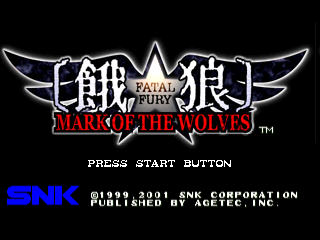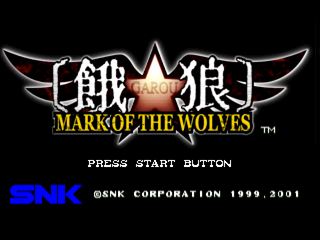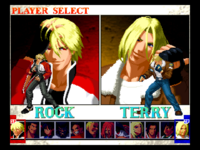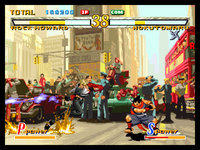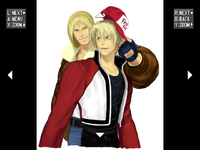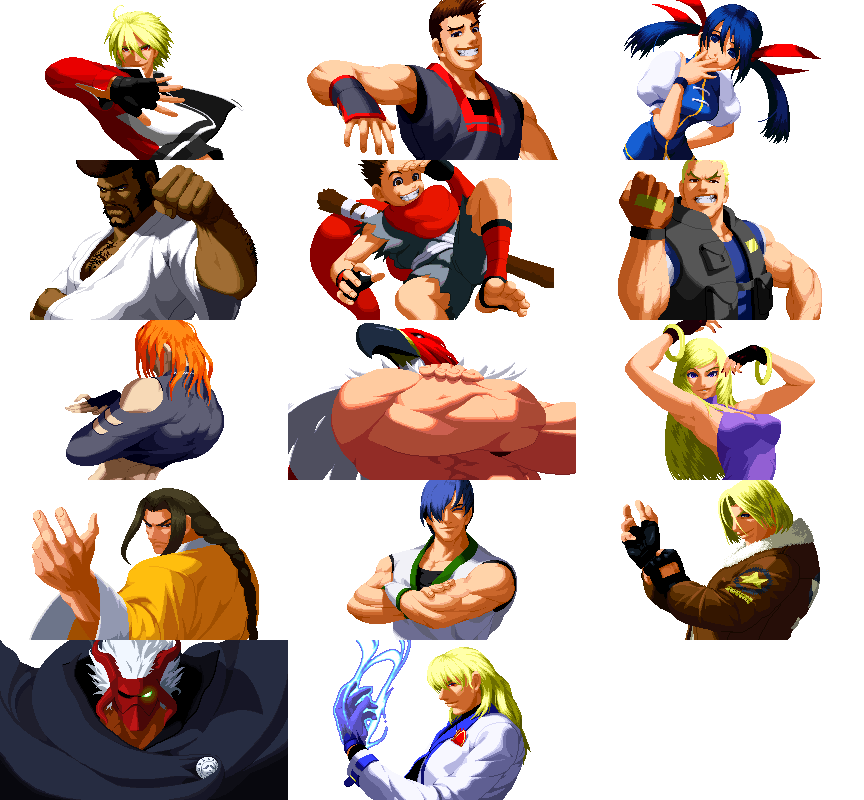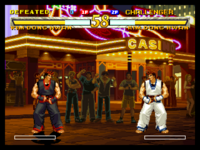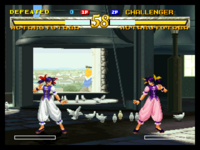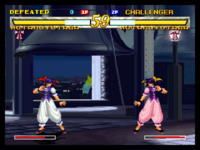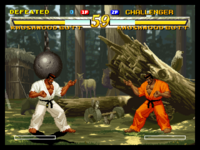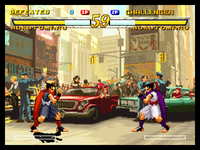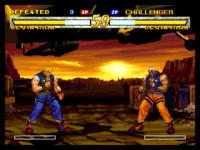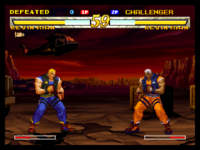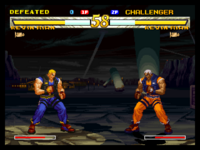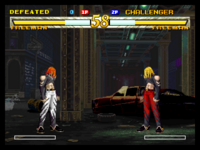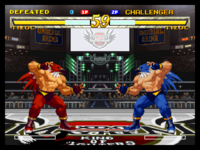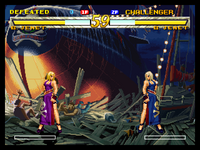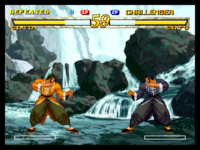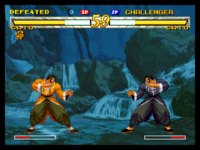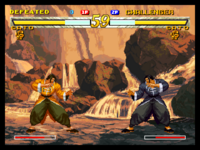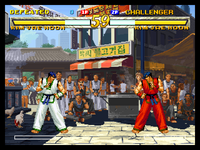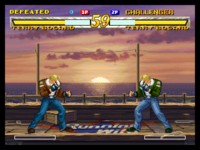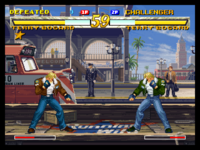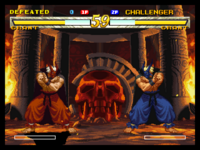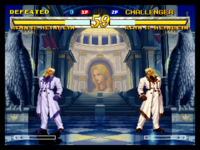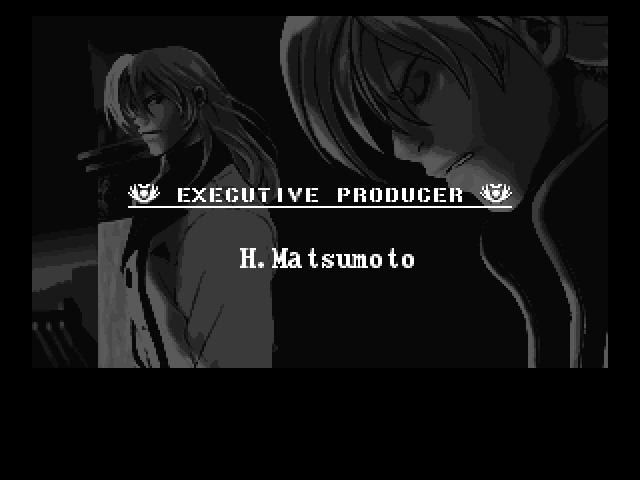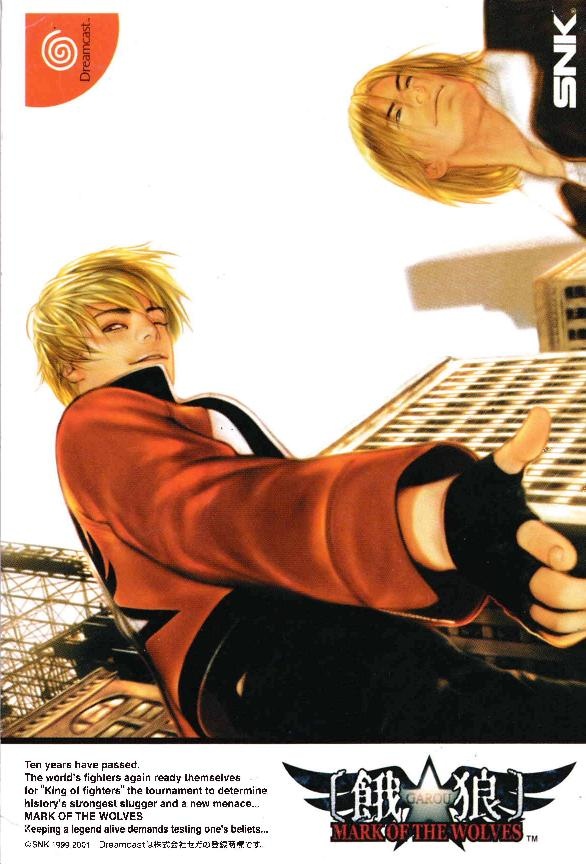Difference between revisions of "Fatal Fury: Mark of the Wolves"
From Sega Retro
Hyperspeed34 (talk | contribs) |
|||
| (4 intermediate revisions by 4 users not shown) | |||
| Line 102: | Line 102: | ||
{{MoveListRow | Shine Knuckle | {{QCF}} {{QCF}} {{LK}} (Super)<br>{{QCF}} {{QCF}} {{HK}} (Power) | Rock charges forward with a burning fist. | {{MoveListRow | Shine Knuckle | {{QCF}} {{QCF}} {{LK}} (Super)<br>{{QCF}} {{QCF}} {{HK}} (Power) | Rock charges forward with a burning fist. | ||
{{ESMove | desc=Power move | Rock charges forward with a burning fist. If it connects, Rock follows up with an elbow strike, then spins into the air while upside down and holding an arm out.}}}} | {{ESMove | desc=Power move | Rock charges forward with a burning fist. If it connects, Rock follows up with an elbow strike, then spins into the air while upside down and holding an arm out.}}}} | ||
| − | {{MoveListRow | Deadly Rave Neo | {{HCB}} {{right}} {{LP}}, {{LP}} {{LP}} {{LK}} {{LK}} {{HP}} {{HP}} {{HK}} {{HK}}, {{ | + | {{MoveListRow | Deadly Rave Neo | {{HCB}} {{right}} {{LP}}, {{LP}} {{LP}} {{LK}} {{LK}} {{HP}} {{HP}} {{HK}} {{HK}}, {{QCB}} {{HP}} | Rock performs a series of attacks, ending by throwing an energy burst from his hands.}} |
}} | }} | ||
}} | }} | ||
| Line 492: | Line 492: | ||
==History== | ==History== | ||
===Legacy=== | ===Legacy=== | ||
| − | ''Mark of the Wolves'' is notable for being the last game to be released by [[SNK]] | + | ''Mark of the Wolves'' is notable for being the last game to be released by [[SNK]]'s original incarnation. The "SNK Best Buy" re-release of this game would be handled by Playmore. |
The K groove fighting style in ''[[Capcom vs. SNK 2]]'' adopts the "Just Defend" system from this game. | The K groove fighting style in ''[[Capcom vs. SNK 2]]'' adopts the "Just Defend" system from this game. | ||
| − | The game was the | + | The game was the latest entry in the ''[[:Category:Fatal Fury (franchise)|Fatal Fury]]'' series until ''Fatal Fury: City of the Wolves'' was announced in 2023. |
==Versions== | ==Versions== | ||
| Line 519: | Line 519: | ||
*'''B. Jenet:''' Rei Saitoh | *'''B. Jenet:''' Rei Saitoh | ||
*'''Khushnood Butt:''' Hikaru Hanada | *'''Khushnood Butt:''' Hikaru Hanada | ||
| − | *'''Hokutomaru:''' Junko Takeuchi | + | *'''Hokutomaru:''' [[Junko Takeuchi]] |
*'''Freeman:''' Eiji Yano | *'''Freeman:''' Eiji Yano | ||
*'''Tizoc:''' Hikaru Hanada | *'''Tizoc:''' Hikaru Hanada | ||
| Line 525: | Line 525: | ||
*'''Grant:''' You Kitazawa | *'''Grant:''' You Kitazawa | ||
*'''Kain R. Heinlein:''' Jun Hashimoto | *'''Kain R. Heinlein:''' Jun Hashimoto | ||
| − | *'''Marky:''' Junko Takeuchi | + | *'''Marky:''' [[Junko Takeuchi]] |
*'''Narrator:''' Paul G.R. | *'''Narrator:''' Paul G.R. | ||
{{creditsheader|Staff}} | {{creditsheader|Staff}} | ||
| Line 587: | Line 587: | ||
| disc=FFMotW DC JP Disc Best.jpg | | disc=FFMotW DC JP Disc Best.jpg | ||
| inlay=FFMotW DC JP Inlay Best.jpg | | inlay=FFMotW DC JP Inlay Best.jpg | ||
| + | | manual=GarouMarkWolvesSNK-DC-JP-Manual.pdf | ||
}}{{Scanbox | }}{{Scanbox | ||
| console=Dreamcast | | console=Dreamcast | ||
| Line 600: | Line 601: | ||
==Technical information== | ==Technical information== | ||
{{mainArticle|{{PAGENAME}}/Technical information}} | {{mainArticle|{{PAGENAME}}/Technical information}} | ||
| − | |||
| − | |||
| − | |||
| − | |||
| − | |||
==External links== | ==External links== | ||
Latest revision as of 16:14, 30 October 2024
| ||||||||||||||||||||
| Fatal Fury: Mark of the Wolves | ||||||||||||||||||||
|---|---|---|---|---|---|---|---|---|---|---|---|---|---|---|---|---|---|---|---|---|
| System(s): Sega Dreamcast | ||||||||||||||||||||
| Publisher: Agetec (US), SNK (Japan), Playmore (Japan; SNK Best Buy) | ||||||||||||||||||||
| Developer: SNK | ||||||||||||||||||||
| Peripherals supported: Dreamcast Arcade Stick, Jump Pack, Visual Memory Unit, Dreamcast VGA Box | ||||||||||||||||||||
| Genre: Fighting Action/Kakutou Action (格闘アクション)[1][2], Action[3] | ||||||||||||||||||||
| Number of players: 1-2 | ||||||||||||||||||||
| ||||||||||||||||||||
|
Fatal Fury: Mark of the Wolves, known as Garou: Mark of the Wolves (餓狼 MARK OF THE WOLVES) in Japan, is a versus fighting game by SNK. It was originally released for the Neo Geo, then ported to the Sega Dreamcast. It is part of the Fatal Fury series.
The American Dreamcast release by Agetec is the only version of the game to use the Fatal Fury name (including the Western localizations for other platforms).
Contents
Story
Ten years have passed since the death of crime lord Geese Howard, and the city of South Town has become more peaceful. A new fighting tournament called "King of Fighters: Maximum Mayhem" starts in the neighboring city of Second South Town, hosted by the wealthy Kain R. Heinlein. Several characters related to the fighters from the previous King of Fighters tournaments are drawn to participate in it.
Gameplay
The game is a 2D fighting game in the Fatal Fury series, but multiple major changes were made to distinguish it from the prior entries. It contains an almost entirely new cast of characters, with only series regular Terry Bogard returning. Rock Howard, the son of series antagonist Geese Howard, makes his debut as the protagonist of the game. Several other characters are relatives or disciples of other Fatal Fury characters and use similar fighting styles. The game foregoes the lane-switching mechanics of its predecessors and returns to a layout of four attack buttons (not used since Garou Densetsu 3), bringing the gameplay more in line with SNK's The King of Fighters series.
Characters move with ![]() and
and ![]() and crouch with
and crouch with ![]() . They backstep or run with
. They backstep or run with ![]()
![]() or
or ![]()
![]() . They jump upward with
. They jump upward with ![]() ; holding
; holding ![]() jumps higher than tapping
jumps higher than tapping ![]() . They jump behind and ahead with
. They jump behind and ahead with ![]() or
or ![]() . Characters can perform a light punch with
. Characters can perform a light punch with ![]() , a strong punch with
, a strong punch with ![]() , a light kick with
, a light kick with ![]() , or a strong kick with
, or a strong kick with ![]() . Characters have different attacks depending on whether they are standing, crouching, or jumping. Characters can taunt with
. Characters have different attacks depending on whether they are standing, crouching, or jumping. Characters can taunt with ![]() , which is a short animation during which the character is vulnerable to attack.
, which is a short animation during which the character is vulnerable to attack.
Every fighter has special techniques performed by inputting specific directions with an attack button. Every character has one special move that the player can "break" (interrupt) by pressing the light punch and kick buttons simultaneously (![]() +
+![]() or
or ![]() ). This ends the move early so that it can be chained into a combo. Characters can also perform feint attacks by holding the D-Pad forwards or down while pressing both punch buttons together (
). This ends the move early so that it can be chained into a combo. Characters can also perform feint attacks by holding the D-Pad forwards or down while pressing both punch buttons together (![]() +
+![]() ). These are fake versions of their special moves that play the initial animation and sound clip for the move without actually performing the move, in order to bait a response from the opponent.
). These are fake versions of their special moves that play the initial animation and sound clip for the move without actually performing the move, in order to bait a response from the opponent.
Blocking can be done by holding the D-Pad in the opposite direction of the opponent. However, when characters block too much, they become "guard crushed" and momentarily stunned and open for attack. Characters turn red before they are guard crushed. Some attacks can only be blocked while crouching (such as sweeps) or while standing (such as jumping attacks and overhead strikes). Every character can perform an overhead strike by pressing the light punch and kick buttons simultaneously (![]() +
+![]() or
or ![]() ), which can hit characters who are blocking while crouched. If hit in the air, a character can land safely by pressing the light punch and kick buttons simultaneously (
), which can hit characters who are blocking while crouched. If hit in the air, a character can land safely by pressing the light punch and kick buttons simultaneously (![]() +
+![]() or
or ![]() ). The game also introduces the "Just Defend" system, which rewards the player for successfully blocking an attack at the last moment by replenishing a small amount of vitality and by recovering from the block faster (providing a window for the player to counterattack). This can also be done in midair (unlike regular blocking).
). The game also introduces the "Just Defend" system, which rewards the player for successfully blocking an attack at the last moment by replenishing a small amount of vitality and by recovering from the block faster (providing a window for the player to counterattack). This can also be done in midair (unlike regular blocking).
Throws can be performed by holding ![]() or
or ![]() and pressing a strong punch or kick button when next to the opponent. Different characters have different throws available to them. Throws cannot be blocked. After being thrown or knocked down, a character can recover with a short forward roll with
and pressing a strong punch or kick button when next to the opponent. Different characters have different throws available to them. Throws cannot be blocked. After being thrown or knocked down, a character can recover with a short forward roll with ![]() , a short backward roll with
, a short backward roll with ![]() , a long forward roll with
, a long forward roll with ![]() , or a long backward roll with
, or a long backward roll with ![]() .
.
The game introduces a new mechanic called the "Tactical Offense Position" (T.O.P.), indicated by a highlighted area comprising a third of the character's vitality gauge. When the gauge reaches this area, the character enters the T.O.P. mode, granting the ability to use a T.O.P. attack, gradual life recovery, and increased attack damage. The attack bonus increases as the character's vitality decreases. T.O.P. attacks are performed by pressing the hard punch and kick buttons simultaneously (![]() +
+![]() ) and differ by character. Players choose which portion of the vitality gauge (the first, middle, or last third) activates the T.O.P. mode after selecting a character.
) and differ by character. Players choose which portion of the vitality gauge (the first, middle, or last third) activates the T.O.P. mode after selecting a character.
Every character has two super special moves. The character builds the Power Gauge by performing special moves, hitting with normal moves, or being attacked. Whiffing break moves also builds the gauge. When the gauge fills with one level, the character can perform an S.Power move. If the gauge fills with a second level, the character can perform two S.Power moves or one especially powerful P.Power move. The amount that the gauge is filled is carried over between rounds but not between matches.
Modes
The game has the following modes:
- Story Mode: The main single-player mode. The player selects any character and fights six opponents. The last opponent has special dialogue depending on the character chosen. After defeating this opponent, the player faces the boss Grant. As in the previous games, the player is given a rank after every round. If the player manages to win maintain an average of AAA rank in every round and does not lose a round, the final boss, Kain R. Heinlein, is fought. The character's ending is only shown if Kain is defeated. The game can be continued an unlimited number of times if the player loses a match; when continuing, the player may optionally choose a bonus to help, such as starting the match with a full Power Gauge or reducing the difficulty level. A second player can enter the game at any time by pressing START to start a two-player match.
- Survival Mode: A single-player mode where the player must defeat as many opponents as possible while only regaining a small amount of health after each battle.
- Vs Mode: A dedicated two-player mode where players can choose any character, a handicap, and any stage.
- Practice: A training mode where the player can choose any character to play and to fight against. The opponent can be set to stand, crouch, or jump and to be passive, attack, or block. There is no time limit, and the opponent cannot be defeated. The player can toggle T.O.P. or set the Power Gauge to permanent S.Power or P.Power. Taunting causes the opponent to walk forward.
- Gallery: The game includes an artwork gallery with character art. After the Story Mode has been completed for a character, artwork from that character's ending appears in the gallery.
There are eight difficulty levels for computer-controlled opponents. There are also settings to change the time limit (45, 60, or 90 seconds or no limit, with a default of 60) and the number of rounds needed to win a match (1, 2, or 3, with a default of 2). The game saves settings, high scores, and unlocked gallery content to a VMU.
Characters
Note: Move lists assume that the character is facing right. When facing left, ![]() and
and ![]() should be reversed.
should be reversed.
| P | Any punch button |
| LP | Light punch |
| HP | Hard punch |
| K | Any kick button |
| LK | Light kick |
| HK | Hard kick |
Playable
The game features an almost entirely new cast of characters, with only series staple Terry Bogard returning from the previous entries.
Origin:
|
Rock Howard | |||||||||||
The son of series antagonist Geese Howard. He has come to resent his father, particularly after the death of his mother. He was partly raised by his father's archnemesis, Terry Bogard, and fights with moves similar to both.
| ||||||||||||
Origin:
|
Kim Dong Hwan | |||||||||||
The eldest son of taekwondo master Kim Kaphwan. He is more haughty and outgoing than his brother Jae Hoon. He fights with similar techniques as his father, but in his own energetic style. He is a naturally skillful fighter, though he does not take his training seriously.
| ||||||||||||
Origin:
|
Hotaru Futaba | |||||||||||
A young orphan girl who is searching for her missing brother. She is accompanied by her pet marten named Itokatsu (pet sable named Eetto in the English localization). Her fighting style incorporates graceful movements and ki blasts.
| ||||||||||||
Origin:
|
Khushnood Butt (Marco Rodrigues) | |||||||||||
A Brazilian martial artist who learned Kyokugen Karate from Ryo Sakazaki (from Art of Fighting). He enters the tournament to show everyone the might of his technique.
| ||||||||||||
Origin:
|
Hokutomaru | |||||||||||
An adolescent boy and the disciple of Andy Bogard, who enters the tournament at the request of his master. He fights with Shiranui-ryuu Ninjutsu techniques that resemble those used by Andy Bogard and Mai Shiranui.
| ||||||||||||
Origin:
|
Kevin Rian | |||||||||||
A S.W.A.T. officer in Second South Town who is avenging the death of his partner. He is accompanied by his colleague's son, Marky. He fights with explosive moves learned from his S.W.A.T. training.
| ||||||||||||
Origin:
|
Freeman | |||||||||||
A sadistic British serial killer who enters the tournament to find stronger victims to kill.
| ||||||||||||
Origin:
|
Tizoc (The Griffon) | |||||||||||
A heroic luchadore who wears a griffon mask and fights for poor children. He is a large fighter with an array of grappling moves.
| ||||||||||||
Origin:
|
B. Jenet | |||||||||||
A flirtatious heiress who ran away from home to form a band of pirates called the Lillien Knights. She enters the tournament with the intention of finding valuables to pilfer from Kain R. Heinlein's mansion.
| ||||||||||||
Origin: Unknown
|
Gato | |||||||||||
A callous and solitary martial artist who seeks to defeat his father, who murdered his mother. His fighting style resembles kung fu and emphasizes powerful, concentrated strikes.
| ||||||||||||
Origin:
|
Kim Jae Hoon | |||||||||||
The younger son of taekwondo master Kim Kaphwan. He is more serious and diligent in his training than his brother Dong Hwan. He has inherited his father's sense of justice as well as his fighting style.
| ||||||||||||
Origin:
|
Terry Bogard | |||||||||||
The hero of South Town who is nicknamed the "Legendary Wolf" (伝説の狼). He travels with Rock, his adoptive son, competing in tournaments to improve their skills. His appearance was reworked for this game as it was considered outdated.
|
Bosses
The two boss characters are playable in any mode by selecting Rock Howard and pressing ![]() or selecting Terry Bogard and pressing
or selecting Terry Bogard and pressing ![]() .
.
Stages
Every character has his or her own stage where matches are hosted. Any stage can be chosen in the Vs Mode and Practice.
History
Legacy
Mark of the Wolves is notable for being the last game to be released by SNK's original incarnation. The "SNK Best Buy" re-release of this game would be handled by Playmore.
The K groove fighting style in Capcom vs. SNK 2 adopts the "Just Defend" system from this game.
The game was the latest entry in the Fatal Fury series until Fatal Fury: City of the Wolves was announced in 2023.
Versions
Localised names
| Language | Localised Name | English Translation |
|---|---|---|
| English (US) | Fatal Fury: Mark of the Wolves | Fatal Fury: Mark of the Wolves |
| Japanese | 餓狼 MARK OF THE WOLVES | Garou: Mark of the Wolves |
Production credits
- Executive Producer: H.Matsumoto
- Producer: S.Itoh, T.Tsukamoto
- Terry Bogard: Satoshi Hashimoto
- Rock Howard: Eiji Takemoto
- Kim Dong Hwan: Jun Hashimoto
- Kim Jae Hoon: Hiroki Asakawa
- Hotaru Futaba: Yuki Horie
- Gato: Kouji Ishii
- B. Jenet: Rei Saitoh
- Khushnood Butt: Hikaru Hanada
- Hokutomaru: Junko Takeuchi
- Freeman: Eiji Yano
- Tizoc: Hikaru Hanada
- Kevin Rian: You Kitazawa
- Grant: You Kitazawa
- Kain R. Heinlein: Jun Hashimoto
- Marky: Junko Takeuchi
- Narrator: Paul G.R.
- Planner: Kim‑Ken, Y.Oda, Goory, I.Higemura, Yucky
- Foreground Designer
- Chief Designer: SoeSoe.F, Heitarou, Rolly.R, N.Kuroki
- : Futatsu.N, Yuko, G.Ishidaman, D‑Mtl'Uchide, Terarin, K.Naoe, Itokatsu, GI Pinoko, S.Sasada, Yoko.K, Eimotsu, T.Ishikawa
- Background Designer
- Chief Designer: M.Hirano, D.Takagi
- : E.Tsutsui, Shimidi, Tomo, Kumiko.M, Sakura‑E, C.Zanami, R.Nariai
- Special Effects: Tashiboo, T.Masami
- Event Art Design: Kaoruru, M.Hirano, C.Zanami, A.Yamada
- Decorative Design: E.Tsutsui, Kumiko.M
- Ending Art Design: Tonko, Arita "A" Ymt, D.Takagi, Shimidi, K.Naoe
- New Staff: Kohji, Manbu, Z.Kadoma, Zacky
- Programmer
- Main Game: Bo‑Fukunaga
- Sub Game: Dan‑Abe
- Others: Forbidden Air
- Sound: Ackey, Yassun, Hori‑Hori, Okan, Q‑Jirou
- Design Sec.
- Title Design: Nao‑Q
- Illustrator: Tonko, Arita‑"A"Ymt, Shinsuke.M
- 3D Animator: Sakipapa, A.Katakura, Haka, N.Kuroki, Kumiko.M
- Adjuster: K.Asai, Toshiyuki.H, Haruo.K, M.Sawa, H.Shimmei
- Very Special Thanks: Sho‑Chan, Asami Don, Oh!Buchi, S.Kurata, H.Tsujioka, M.Tsujimura, A.Nakao, M.Fujimi, All SNK Staff, and My Family...
Magazine articles
- Main article: Fatal Fury: Mark of the Wolves/Magazine articles.
Promotional material
Physical scans
| Sega Retro Average | |||||||||||||||||||||||||||||||||||||||||||||||||
|---|---|---|---|---|---|---|---|---|---|---|---|---|---|---|---|---|---|---|---|---|---|---|---|---|---|---|---|---|---|---|---|---|---|---|---|---|---|---|---|---|---|---|---|---|---|---|---|---|---|
|
| 75 | |
|---|---|
| Based on 9 reviews | |
| Dreamcast, JP (SNK Best Buy) |
|---|
Technical information
- Main article: Fatal Fury: Mark of the Wolves/Technical information.
External links
- Sega of Japan catalogue pages (Japanese): Dreamcast, Dreamcast (SNK BEST BUY)
- Agetec webpage: Dreamcast
References
- ↑ File:FFMotW DC JP Box Back.jpg
- ↑ 2.0 2.1 2.2 http://sega.jp/dc/010913/ (Wayback Machine: 2008-01-31 22:31)
- ↑ https://sega.jp/history/hard/dreamcast/software_l.html#tab02 (Wayback Machine: 2020-02-01 22:57)
- ↑ 4.0 4.1 http://sega.jp/dc/020502/ (Wayback Machine: 2008-01-30 13:36)
- ↑ http://www.ebgames.com/ebx/categories/homepages/dreamcast/default.asp (Wayback Machine: 2001-12-01 04:48)
- ↑ File:Fatal Fury Mark of the Wolves DC good ending credits.pdf
- ↑ 576 Konzol, "November 2001" (HU; 2001-xx-xx), page 52
- ↑ Ação Games, "Dezembro 2001" (BR; 2001-xx-xx), page 35
- ↑ Consoles +, "Novembre 2001" (FR; 2001-1x-xx), page 144
- ↑ Dorimaga, "2001-09 (2001-09-28)" (JP; 2001-09-14), page 33
- ↑ Dorimaga, "2002-18 (2002-10-11)" (JP; 2002-09-27), page 34
- ↑ Electronic Gaming Monthly, "January 2002" (US; 2001-12-04), page 232
- ↑ Famitsu, "2001-10-05" (JP; 2001-09-21), page 31
- ↑ MAN!AC, "12/2001" (DE; 2001-11-07), page 50
- ↑ PSX Extreme, "11/2001" (PL; 2001-1x-xx), page 49
| Fatal Fury: Mark of the Wolves | |
|---|---|
|
Main page | Comparisons | Development | Magazine articles | Reception | Technical information | Bootlegs | |
| Fatal Fury/Garou Densetsu games for Sega systems | |
|---|---|
| Fatal Fury (1993) | Fatal Fury 2 (1994) | |
| Fatal Fury Special (1994) | |
| Fatal Fury Special (1995) | |
| Garou Densetsu 3: Road to the Final Victory (1996) | Real Bout Garou Densetsu (1996) | Real Bout Garou Densetsu Special (1997) | Real Bout Garou Densetsu Best Collection (1998) | |
| Fatal Fury: Mark of the Wolves (2001) | |
- Dreamcast Arcade Stick-compatible games
- Jump Pack-compatible games
- Dreamcast VGA Box-compatible games
- Visual Memory Unit-compatible games
- 1-2 player games
- JP Dreamcast games
- All JP games
- US Dreamcast games
- All US games
- Dreamcast games
- 2001 Dreamcast games
- All 2001 games
- Dreamcast fighting games
- All fighting games
- Dreamcast games with ADX audio
- Use romtable template
- All games
- Fatal Fury: Mark of the Wolves
- Fatal Fury (franchise)
